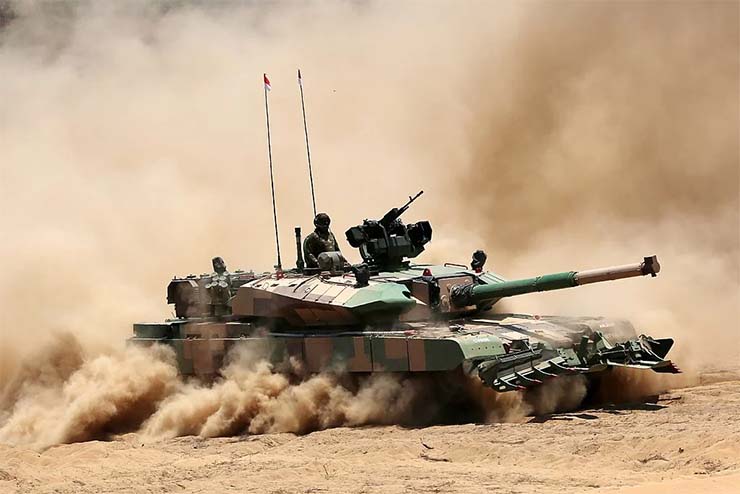
The aftermath of the Armenian-Azerbaijan conflict and more recently the Russian invasion of Ukraine seems to write the epitaph of the main battle tank as a vulnerable mechanical behemoth straddled with huge logistic baggage producing little or no tangible battle-winning outcome. In fact, the legacy of the world war blitzkrieg seems to have been shattered by the ongoing conflict in Ukraine and appears to propagate an eery feeling of questioning the very concept of warfare besides professing that this very change in the nature of combat is pushing tanks into obsolescence.
Regrettably what analysts fail to note is that these recent conflicts are emotional engagements translated into the use of weapons and platforms aimed at inflicting maximum casualties to force unilateral subjugation of the weaker opponent. In the process, tanks are being employed as a show of military might designed to create the desired shock and awe reflective of their political objectives. In the process, it is abundantly clear that from a military standpoint, it is not a strategised military operation as an instrument of state policy designed to neutralise the war-waging potential of the adversary and bring them to the negotiating table as soon as possible with minimum collateral damage and causalities both military and civilian. Instead, the Russian offensive is being fought as a reckless exchange of destructive fire from a variety of platforms targeting Ukrainian military hardware and civilian infrastructure. In so doing they have caused incalculable damage and destruction killing millions of innocent civilian men, women and children. The conflict, waged with utter disregard to the tenents of combined arms operation or humanitarian considerations, whose outcome professes the obsolescence of the main battle tank, cannot be the basis to be judgemental in writing the obituary of the tank.
Therefore, a deeper analysis is mandated to resist the temptation of making sweeping conclusions about the future of warfare based on a conflict, which seems to question the very basics of warfare and whose lessons have to be viewed in the backdrop of the reasons for their operational failures and therefore are not clear as yet and will not necessarily be relevant to future conflicts. As a result, the ineffectiveness of specific weapon systems based on how and where they are employed, may not necessarily be due to their inherent shortcomings but instead could be attributable to their faulty employment. Towards this end, from all available data from Ukraine, as well as the recent war in Nagorno-Karabakh, the indications are that tanks are an indispensable component of combined arms operations and hence remain critical in modern warfare. The armour’s effectiveness is greatly enhanced when used as part of a combined arms team comprising mounted infantry, self-propelled artillery, air defence and engineers supported by requisite logistics. Air and helicopter support remains crucial on the modern battlefield while the recent advent of drones and loiter ammunition are force multipliers.
Unfortunately, in recent engagements, their vulnerabilities have been exaggerated based on the poor battle performance of Russian armour. In fact, Russia’s heavy tank losses can be explained by gross leadership failures, employment blunders, poor planning and preparation, insufficient infantry support, lack of a combined arms approach and exasperated logistic backup. Russian missteps and tank losses during the initial phase of the operation are attributable to their priorities on speed and secrecy of operations. Further, they grossly underestimated the Ukrainian military capability thereby anticipating very little resistance. Hence Russian forces made minimal attempts at executing a coherent combined-arms operation, which would have required careful coordination and planning between air, ground, and naval forces. Instead, Russian ground units simply drove towards cities, unprepared for a fight. The fact that the campaign was launched during peak winters making tank movement road bound is reflective of the political character of the decision to go to war. In addition, it seems apparent that Russian forces were given insufficient time to mobilise for war nor given adequate time to prepare for such a complex operation. This was apparent from the fact that while the Russian military’s doctrine, exercises, and previous conflicts all prioritised combined arms, the actual execution based on a political decision to launch the offensive was launched in battle tactical groups drawn for respective military districts eschewing the tenants of combined arms application. As a result, the progressive phases of this war may not be a good indication of how effective tanks and other systems would prove vis a vis their effectiveness in a better-organised military operation. Many of the supposed weaknesses of manned ground, aerial, and naval platforms were a result of these operational blunders, but certainly not a reflection of their technical relevance in modern warfare.
That apart a large percentage of the damages have been attributed to tanks being abandoned by Russian crew before being destroyed by Ukrainian soldiers who either could not or chose not to capture them. Thus, close to 50 per cent of Russia’s documented tank losses have been first abandoned by their crews before they were destroyed. In other words, the tanks themselves were not the problem — they were simply poorly manned and employed.
At the tactical level, Russia’s tank losses were primarily due to faulty choice of axes for tank movement and exacerbated logistics issues, besides insufficient infantry to protect them. Russian tank units lacked sufficient close infantry support. This is one of the major reasons for Russian losses which was most pronounced due to the lack of sufficient manpower in BMP units. Russia chose to reduce the strength of motorised rifle battalions on BMP Infantry Fighting Vehicles and many of the battalions that invaded Ukraine were only at two-thirds to three-quarters strength. In practice, this meant that Russian motorised rifle units lacked sufficient dismounts for fighting in urban terrain. Russia also chose to reduce the motorised rifle battalion in each tank regiment to a single company, which was grossly insufficient to support the two battalion tactical groups that each tank regiment was required to generate. Thus, it is no surprise that Ukraine adopting a positional defence, had significant success in targeting Russian tanks with anti-tank teams. Complimenting the efforts of anti-tank missiles were accurate artillery and drone engagements aided by the poor communication discipline that gave away Russian locations.
While it is a known fact that tanks are logistics-intensive, they require sustained maintenance, and substantial fuel to keep them operational. Because of these requirements, logistics planning is an essential component of armoured warfare. Unfortunately, Russia’s disorganised invasion exacerbated these logistical challenges resulting in tanks running out of fuel thereby falling prey to the Ukrainian drone attack. That apart Russia’s operation was marked by extreme efforts at compartmentalisation and secrecy, with most soldiers getting to know the reasons for going to war only a few hours before the invasion. As a result, commanders and logisticians were given insufficient warnings to plan and prepare. Tank units did not have enough time to schedule proper maintenance or to procure sufficient spare parts, fuel, and other items necessary for a conventional war. It is indeed a surprise that the Russian military should so blatantly eschew basic issues of mobilisation and battle preparations.
At the operational level, Russia’s plan involved too many axes of advance, many of which were not mutually supporting. That apart, Russian Ground Forces units were tasked to advance at an extremely rapid rate. As a result, Russian forces often moved way beyond artillery, electronic warfare, and air defence coverage, thereby exposing the columns to artillery and drone attacks besides compounding logistics issues. The rapid advance also meant that Russia had longer and more exposed supply lines, and its logistics convoys were subjected to frequent ambushes by Ukrainian territorial defence forces. It is not surprising that the performance of tank units had to be abysmal owing to the blatant abandonment of tanks for a multitude of reasons ranging from lack of fuel to communications, to as basic as poor selection of routes of advance.
The Russian invasion of Ukraine has produced a deluge of analyses and commentary on the role of the battle tank. Most of the debate has centred on whether it has reached obsolescence given the decimation of Russian tanks forces. However, analysis has conclusively conceded that a large number of Russian tank losses are due to a combination of reasons most pronounced among them have been abandonment and outright capture. The crucial factor that many observers of the Russia-Ukraine war fail to see is the low morale and uninspiring leadership. This played a key role in undermining the operational performance of Russian tank commanders and crew. Therefore, it is grossly incorrect to pronounce the obituary of the tank based on the outcome of these conflicts. However, while the dynamic contest between tank and anti-tank is not new, the emergence of drones is yet another facet in the development of tanks calling for a renewed focus on inbuilt anti-drone capability as well as deployment of drones from tanks for surveillance and reconnaissance. It also calls for a radical restructuring of armed units most importantly the inbuilt reconnaissance component. Properly equipped and handled by well-trained crews, the tank still remains the most potent weapon system on the battlefield, albeit as part of the combined arms team. The Russians went away from their own teachings on the deep battle and the combined arms concept and paid the price
Thus, the enduring importance of tanks cannot be overemphasised. The conflicts in Ukraine and Nagorno-Karabakh have shown the vulnerabilities of the tank but have also conclusively proved that mobile armoured platforms with effective firepower employed with adequate combined arms and logistics support are the mainstay of any future conflict. History is replete with examples, where improved versions of the tank have dealt with vulnerabilities and they continue to dominate the modern battlefield. Apart from its devastating physical capabilities, the shock and awe produced by tanks are yet to be replicated by any other weapon system. The tank is here to stay.
–The writer is a former GOC-Indian Army and presently a Strategic Consultant, Principal Advisor. Views expressed are personal and do not necessarily reflect the views of Raksha Anirveda











